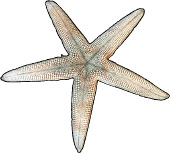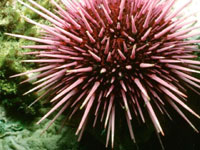Echinoderms
 |
| A sea star is radially symmetrical. |
Radial symmetry means that the body is a hub, like a bicycle
wheel, and tentacles are spokes coming out of it (think of a starfish).
As larvae, echinoderms are bilaterally symmetrical. As they mature, they
become radially symmetrical.
Most adult echinoderms live on the bottom of the ocean
floor. Many echinoderms have suckers on the ends of their feet that are
used to capture and hold prey, and to hold onto rocks in a swift current.
Sea Stars
 Sea
stars (group name Stelleroidea) are sometimes called starfish, though they
are not real fish (they lack both vertebrae and fins). There are two sub-types
of sea stars: Sea
stars (group name Stelleroidea) are sometimes called starfish, though they
are not real fish (they lack both vertebrae and fins). There are two sub-types
of sea stars:
Asteroideas are the true sea
stars and sun stars.
Ophiuroideas are brittle stars
and basket stars.
The differences between the two sub-types lies in how the
arms connect to the central disk. Ophiuroids have arms that do not connect
with each other. There is a distinct boundary between arm and central disk.
Asteroids have arms that are connected to each other. Also, it is harder
to tell with asteroids where the central disk ends and the arms begin.
The sea star's top surface (or skin) looks spiny if you
examine it. If you look very closely you will notice that there are different
types of growths on the surface. Some bumps are used to absorb oxygen,
they are called dermal branchiae. Pedicellaria are pincher-like organs
used to clean the surface of the skin. Barnacle larvae could land on a
sea star and start growing if it were not for these organs.
How Do Sea Stars Move?
 Each
sea star had hundreds of tiny feet on the bottom of each ray. These are
tube feet, or podia. These tiny feet can be filled with sea water. The
vascular system of the sea star is also filled with sea water. By moving
water from the vascular system into the tiny feet, the sea star can make
a foot move by expanding it. This is how sea stars move around. Muscles
within the feet are used to retract them. Each
sea star had hundreds of tiny feet on the bottom of each ray. These are
tube feet, or podia. These tiny feet can be filled with sea water. The
vascular system of the sea star is also filled with sea water. By moving
water from the vascular system into the tiny feet, the sea star can make
a foot move by expanding it. This is how sea stars move around. Muscles
within the feet are used to retract them.
Each ray of a sea star has a light sensitive organ called
an eyespot. Though it can not see nearly as well as we do, sea stars can
detect light and its general direction. They have some idea of where they
are going.

Can Sea Stars Grow New Arms?
Given enough time, sea stars can grow back arms that
have been damaged or removed. For a few species, the severed arm can grow
back into a complete sea star! For most sea stars, however, a severed limb
dies.
What Do Sea Stars Eat?
Sea stars eat many things. A sea star's diet can include:
barnacles, snails, sea urchins, clams, and mussels. A few species, such
as the spiny star of the North Atlantic, eat other sea stars! Many sea
stars eat mussels and clams in an interesting way. They surround the shell
and use the suckers on their feet to pull the two shells (or valves) apart.
The sea star has enough force in its arms to actually bend the shell! This
creates an opening between the two shells that is only .01 inches wide.
Using this tiny gap, the sea star puts its stomach into the clam's shell
and eats its insides. When it is done, nothing is left but an empty shell.
Sea Urchins & Sand Dollars
 Sea
urchins, heart urchins, cake urchins, and sand dollars belong to a sub-group
of echinoderms called enchinoidea. These creatures have many sharp spines
pointing out in all directions that offer protection from predators. Sea
urchins, heart urchins, cake urchins, and sand dollars belong to a sub-group
of echinoderms called enchinoidea. These creatures have many sharp spines
pointing out in all directions that offer protection from predators.
The spines are connected to the skeleton in a ball-joint
manner called the "test." Spines are able to swivel towards a predator
because they are connected to muscles.
These animals have five paired rows of tube feet with
suckers. The mouth is on the bottom, and the anus on top. The mouth contains
five teeth that point towards the center. The tubed feet are used to move
along the bottom of the sea, where these organisms use their teeth to eat
algae.
Sea Cucumbers
Sea cucumbers belong to a sub-category of echinoderms
called holothuroidea. Some members of the group look like cucumbers you
find in the supermarket. The similarity ends there.
Sea cucumbers are football shaped creatures that lay on
their side at the bottom of the ocean. They have five rows of tube feet
running lengthwise. Its mouth is surrounded by tentacles that are really
tubed feet. Unlike sea stars, the vascular system is not filled with sea
water. Instead, sea cucumbers use a special body fluid.
Sea cucumbers eat plankton and other organic matter. Some
position themselves in a current that brings a steady supply of food, and
spend hours there. The tentacles open up and collect food in the current.
The sea cucumber brings each tentacle to its mouth to eat, while the other
tentacles go on collecting food. Other sea cucumbers feed by sifting through
sand using their tentacles.
How Do Sea Cucumbers Protect
Themselves?
Many sea cucumbers are poisonous. If injured, sea cucumbers
can kill fish in the same aquarium as them.
The sea cucumber has an interesting way of defending itself—a
sea cucumber can expel (throw out) all of its internal organs! This either
scares off or satisfies predators. The sea cucumber can then grow another
set of internal organs.
Some sea cucumbers secrete a very
sticky substance as a defense mechanism. If you get this glue on your body,
you will not be able to remove it without shaving your skin!
  
|
